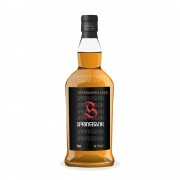Springbank Blackadder Raw Cask 1995/2005
Comparison: official bottling vs BA
0 688
 Review by @Pandemonium
Review by @Pandemonium

- Nose23
- Taste22
- Finish21
- Balance22
- Overall88
Show rating data charts
Distribution of ratings for this:
- Brand: Springbank
- Type: Scotch
- Region: Campbeltown
- ABV: 58.4%
Another week, another Blackadder Raw Cask, I really need to lay off these bottles, they are quite addictive. On today's menu, a young Springbank at cask strength, from 1995, bottled in 2005. I will compare it to an official 10yo bottling from 2010.
Colour: Blackadder: Pale gold,reminds me of the Macallan Gold, no colour was added, nice natural colouring distinctive of the American oak cask (however, it matured in a Sherry Pipe!). But by God,so much residu from the cask is left in this one. Springbank: Slightly darker, the range of colouring leans more towards red-brown (E150?)
Nose: Blackadder: Eucalyptus, hints of vix rub, walnut oil and genever seasoned in oak casks. (with water added): no genever, more like brandy now and lamb roast with rosemary, Springbank: Hints of salt, grain, smoked bacon, pine resin with a much more farmy quality to it
Mouth: Blackadder: Dried oranges, tea, a whiff of peat. (with water added): But also fruity (unlike the nose suggested): apples, grapefruits and quinces, vine flowers, and salty liquorice. Springbank: Hints of orange and lemon, pepper, tea, hints of salt and wood scrapings, much more peat added to the mix and some spices lingering in the background.
Finish: Blackadder: Long and warm, but surprisingly dry and bitter, salt breaks through, replacing the earlier sweetness. Springbank: Long and pleasant, with notes of fresh peat, slices of lemon and rough grind pepper (no saltiness here)
Conclusion: Not quite the same dram is it now? I think the official 10yo bottling is quite impressive actually, so young and vibrant, this is an entry-level malt that comes at a more than reasonable price and blows the competition from the same price-level completely away. But hey, we don’t expect anything less from the Springbank Distillery Now the Blackadder is something else, that both these drams come from the same distillery shouldn’t come as a complete surprise, they are obviously sisters. But the Blackadder developed quite a different nose and finish, I dare say that the bodies had a lot of elements in common, The menthol scents where something I hadn’t encountered yet, but proved to be essential for this tasty dram. Who won? The Blackadder, but the official bottling came in a close second. The main advantage of the official Springbank was that only did cost a fraction of the price I paid for the Blackadder.
Find where to buy Springbank whisky








Interesting review but I have a couple of comments and questions.
The question of colouring...Springbank bottled in 2010 would not have had any added colour as far as I am aware. There are many things that can contribute to differences in colour. The OB likely is a mix of first fill and refill casks. Do we know if the Blackadder was from a refill or first fill cask? And does colour really have a bearing on flavour?
The other question is, what strength was the. OB? Most reviews I have read mention 46%. Is it really fair to compare a CS with 46%?
Just asking. It sounds like both are good, but very different...